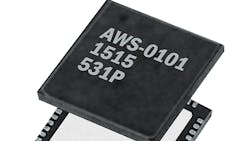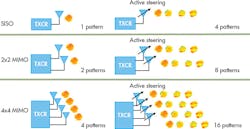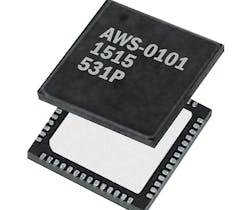Antenna Performance Soars into the Stratosphere
This file type includes high-resolution graphics and schematics when applicable.
Though they may be overlooked at times, antennas play a vital role in the performance of any wireless system. Whether it is a critical military application or a home Wi-Fi network, antenna solutions are heavily relied on when it comes to transmitting and receiving information wirelessly. Innovative solutions include antenna arrays, such as active electronically scanned arrays (AESAs), which are finding homes in a range of applications.
Given their already critical nature and the seemingly endless new applications, antennas are evolving to keep pace performance-wise. In fact, many recent advances and developments throughout the RF/microwave industry could not move forward without the right antenna.
Wireless Data Congestion
Wireless carriers are running out of network capacity due to the steadily mounting data traffic. One company, Ethertronics, believes it can help overcome these challenges with its Active Steering technology. According to the company, Active Steering can achieve performance levels that are unattainable with traditional passive antennas. Ethertronics boasts that its technology offers high data rates and can minimize unwanted interference. In addition, increased spectral efficiency provides carriers with more network capacity.
With Active Steering, multiple radiation patterns can be generated from a single antenna structure (Fig. 1). Therefore, one antenna can basically operate as four different antennas. For instance, when Active Steering is implemented in a standard access point with four antennas, 16 unique radiation patterns and 256 pattern combinations can be generated for the antenna system. An algorithm samples and switches between the different radiation patterns to select the best one to use for the specific environment. As a result, Active Steering can dynamically respond to changing RF conditions fast enough to minimize multipath fading.
Ethertronics recently announced a complete Wi-Fi Active Steering antenna system, which the company says can improve coverage and signal quality by 50%. Up to a 3-dB boost in network performance is possible for a wide range of Wi-Fi devices, too. Such devices include access points, set-top boxes, and smart gateways. The company feels that enhanced antenna performance in today’s home Wi-Fi networks will help overcome a major bottleneck.
“Array techniques have been applied in the form of smart antennas for IEEE 802.11a/b/g systems since 2004,” says Jeff Shamblin, chief scientist at Ethertronics. “More recently, digital beamforming techniques have been applied to IEEE 802.11n and IEEE 802.11ac systems. The recent introduction of IEEE 802.11ac allows for 8 × 8 multiple-input, multiple-output (MIMO), where as many as eight antennas can be used for MIMO or beamforming applications. Multi-user MIMO (MU-MIMO) is also implemented in IEEE 802.11ac, where one or multiple antennas are used to communicate with one client, while one or multiple antennas in the system are used to communicate with a second client simultaneously.”
Shamblin adds, “For example, pairs of antennas can be used to communicate with four clients simultaneously in an 8 × 8 system. These pairs of antennas can be antennas operating in a MIMO mode where each antenna operates individually. These antennas can also be grouped into a two-element array or used in a two-element digital beamforming application.
“It is important to note that antennas in a Wi-Fi system are switched from MIMO to digital beamforming mode and back,” continues Shamblin. “For the most optimal MIMO performance, the antennas in a system are typically positioned such that they have different radiation patterns and/or different polarizations—all in an attempt to reduce the envelope correlation coefficient (ECC) between antennas. For better array performance, the opposite scenario is preferred. The radiation patterns and polarizations of the antennas used to populate the array are the same, which results in optimum array performance in terms of peak gain and beamwidth characteristics and control. Our Active Steering technology allows for each antenna in a system to be optimized. The system switches antennas from MIMO to digital beamforming modes by selecting the best radiation pattern per packet/client during operation.”
AESA for Radar
Active electronically scanned array (AESA) technology powers many of today’s radar systems. The technology is a key component of many advanced weapons systems—airborne warfighting in particular. AESA typically utilizes a large number of transmit/receive circuits arranged in a pre-determined configuration and connected to an array of radiator elements. These elements collectively transmit and receive a beam of RF pulses to and from a target.
Raytheon’s AN/APG-63(V)3 radar system, which is used to power F-15 aircraft, takes advantage of AESA technology. Benefits of this radar system include multi-role capability, long-term support, and easy future growth options. The system, used by the U.S. Air Force, Air National Guard, and multiple coalition partners around the world, has certainly spread its wings—Raytheon recently delivered its 200th AN/APG-63(V)3 radar system. The system’s reputation is that it’s significantly more reliable than older mechanically scanned array radars, which translates into sustained savings and increased availability. Overall, Raytheon has delivered more than 800 AESA radars since introducing the technology in 2000.
In addition to military systems, AESA technology is finding its way into commercial applications. One company thriving in this space is Anokiwave with its integrated-circuit (IC) solutions for commercial AESA applications (Fig. 2). The firm recently extended its X-band AESA family, which is intended for commercial radar and 5G communications markets, by releasing two new ICs for single-beam receive (Rx) and transmit (Tx). Anokiwave believes that commercial AESAs represent the future in this arena.
Each IC in the family includes an integrated four-channel beamformer, low-noise amplifier (LNA), and power amplifier (PA). Four radiating elements are supported. Customers can opt for devices with either low noise figure or high input linearity. The ICs are further classified as either dual-beam Rx/single-beam Tx or single-beam Rx/single-beam Tx.
Specifically, the AWS-0101 is a low noise figure, dual-beam Rx/single-beam Tx device, while the AWS-0103 is a high input linearity, dual-beam Rx/single-beam Tx device. The AWS-0104 and AWS-0105 are both single-beam Rx/single-beam Tx ICs. The AWS-0104 maintains a low noise figure, while the AWS-0105 provides high input linearity.
All devices include six-bit phase and six-bit gain control. Additional features include gain compensation over temperature, temperature reporting, and forward power telemetry with programmable delay power sampling. In addition, fast beam switching uses on-chip beam weight storage registers that can be accessed via direct address lines.
API Technologies also offers active antenna array solutions for AESA radar. By taking a line-replaceable-unit (LRU) approach, the company developed a solution that is intended to streamline system integration, simplify repair, and reduce the cost of ownership of AESA radar platforms. Known as the Active Antenna Array Unit (AAAU), this solution consists of common transmit/receive module building blocks called Quad Transmit Receive Modules (QTRMs). The AAAU targets applications such as datalinks, satellite-communications (satcom), and radar.
To summarize, many applications stand to benefit from recent antenna developments. As wireless communications assume a greater role in each of our lives, proficient antenna performance becomes paramount. New technology, such as Active Steering, aims to overcome the challenges of heavy wireless data traffic. And AESA technology will look to drive commercial and military applications. Stay tuned for more antenna advances in the coming weeks.



